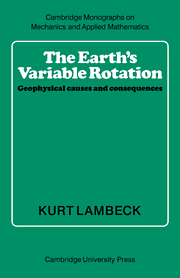Book contents
9 - Decade fluctuations
Published online by Cambridge University Press: 06 October 2009
Summary
In this chapter I discuss the fluctuations in the Earth's rotation in the frequency range from about 0.2 cycle yr–1 to very low frequencies. These are often referred to loosely as the decade fluctuations, although they cover a much longer-period range from, say, 5 yr to Newcomb's Great Empirical Term of 300 yr. The astronomical evidence for these fluctuations in both wobble and l.o.d. has been discussed in chapter 5, and it is in the l.o.d. that they are most pronounced and well above the observational noise level. Most of the discussion will, in consequence, concern the l.o.d. decade variations. Observed since the early nineteenth century, these changes are illustrated in figure 5.3 in the form of m3 and m3. The characteristic time constant of the changes is 10-20 yr. Since the introduction of atomic time in 1955, the improved observations are indicative of a shorter time constant, about 5 yr. The wobble observations suggest a secular drift of the pole upon which an approximately 20-yr oscillation appears to be superimposed. But the reality of this term is open to question and may be a characteristic of the observing process itself, rather than of some geophysical excitation (see section 5.3).
The geophysical origin of the decade fluctuations has been subject to considerable debate and most discussions have centred around the possible role of the core.
- Type
- Chapter
- Information
- The Earth's Variable RotationGeophysical Causes and Consequences, pp. 245 - 285Publisher: Cambridge University PressPrint publication year: 1980

